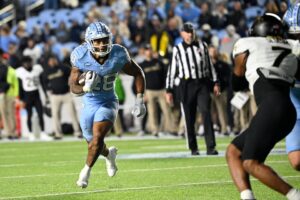Mountaineers 2020: Previewing Kansas State
Football, they say, is a game of inches. The old adage remains true today. Even a few small lapses–the figurative “inches”–cost teams wins. Unfortunately, West Virginia saw two such plays that would have changed last week’s outcome. Instead of dwelling too much on the loss, however, the Mountaineers are moving on. After a brief look at what we saw against Texas Tech, we are previewing Kansas State. The weekend tilt in Morgantown between the Mountaineers and Wildcats kicks off at noon. ESPN2 will televise the game.
The Rundown: Texas Tech
We could say a lot about the Mountaineers’ loss to Texas Tech. The defense took a step back in the first half. They did not seem as aggressive as they had been against dual threat Henry Colombi, and the Red Raiders took advantage. Texas Tech accumulated 20 first-half points and 235 yards (111 on the ground). But the defense adjusted in the locker room and gave up only 7 points and 113 yards in the second half. Unfortunately, the offense gave away 7 points late on a Sam James fumble, and the Mountaineers found themselves unable to recover, losing 34-27.
While we do not generally take positives away from a loss, the loss also does not necessarily predict “darker days” ahead. Certainly, continuing dropped passes (there were a total of six, and five different receivers were responsible for at least one) plague the offense. In the first half, however, the receivers dropped only one pass. Indeed, but for a holding penalty negating a Leddie Brown touchdown reception (forcing the Mountaineers to settle for a field goal) and an overthrow by Jarret Doege to a streaking Winston Wright (who would have walked into the end zone untouched) on fourth down in plus territory, the Mountaineers go into the half with a 27-20 lead.
In short, this was hardly the game to which we might point for evidence that, say, Neal Brown needs to stop directing the offense, as some others have argued. The game plan and play calling looked fine. But minor issues in the execution did not. And those small errors–those were the inches that governed the result.
Previewing Kansas State
Dotting the I’s
As usual, Kansas State makes up for a lack of abundant high-level talent with a disciplined, hard-working approach. They win games by limiting turnovers (they have two through five games), by forcing teams to make plenty of their own (ten takeaways this season), and by making big plays on special teams (two punt returns for touchdowns so far).
Oddly, for as disciplined as the team has been in every other department, the Wildcats suffer the same penalty “bug” as the Mountaineers. So far, Kansas State has been called for 40 penalties for 369 yards (an average of 8 penalties and 74 yards per game. For once, then, penalties–particularly if West Virginia can cut a few out–might give a slight advantage to the Mountaineers. No doubt the Mountaineers need every advantage they can get.
The Offense
Will Howard replaced Skylar Thompson as the Wildcats’ starter against TCU, and Kansas State is 2-0 since the move. Howard is yet another dual threat quarterback the Mountaineer defense will have to face. He scampered for an 8-yard touchdown run so far this season, so the running threat is legitimate. Deuce Vaughn handles the majority of the Wildcats’ carries, running for 319 yards on 61 attempts (just over five yards per carry). He scored four touchdowns on the season. Vaughn is also the team’s leading receiver with 360 yards (and another touchdown). Chabastin Taylor and Briley Moore prove perfectly capable weapons, too.
Overall, however, Kansas State averages only 370 yards per game. Offensively, they average just under 30 points a game (with another 5 points a game scored by their defense or special teams). The 2020 Wildcats run more than they throw, dialing up a carry 59% of the time. Their line has surrendered only seven sacks, but they also average just north of three-and-a-half yards per carry. As a result, the Wildcats’ offense has lacked efficiency and the run-heavy attack has not translated to clock control by the unit.
The Defense
Not surprisingly, the defense is fundamentally sound, surrendering just 24 points per game. Through the air, the Wildcats give up a decent completion rate (65%) but keep most plays in front of them, surrendering just 6.6 yards per attempt through the air. They are slightly more vulnerable on the ground, giving up nearly five yards per carry. As noted above, the Wildcats remain opportunistic, forcing two turnovers per game and averaging just under three sacks per game. Falling short of “dominant,” the Kansas State defense remains plenty capable.
Yards to Gain: What West Virginia Must Do to Win
Feed Leddie Brown
From a sheer efficiency standpoint, Kansas State fares worse against the run. Brown has proven capable of exploiting such a weakness, netting just under six yards per carry. Brown hit pay dirt nine total times this season (seven on the ground), and, to win, the Mountaineers need him to see another 100 yard performance with a touchdown or two. Feeding him early and often should soften the defense exponentially as the game wears on.
Get the Passing Game Components on the Same Page
Fans focus heavily on the dropped balls by the receivers after the loss to Texas Tech. It’s understandable. The receivers’ job is to catch the ball. When they do not, they receive criticism. But the loss cannot be pinned solely on the receivers. In the first half, the receivers dropped only one pass (a Sean Ryan drop in the first possession). Doege, on the other hand, outright missed on six throws. As mentioned above, one such miss was a fourth down throw to a wide open Wright that cost the Mountaineers an easy score.
In the second half, however, the roles reverses. The receivers dropped five passes. Doege only missed outright on two throws. Drops killed several drives. Given that the Mountaineers played an pretty clean second half (only two penalties), the drops take center stage.
Against Kansas State, though, the Mountaineers need to get everyone on the same page. The receivers who are catching the ball are the ones who need to be targeted. Doege must also get himself under control and make sure that, when his receivers run crisp routes into the soft spots in the zone, he finds them.
Limit Penalties and Big Special Teams Plays
Kansas State is dangerous on special teams, particularly in the punt return unit. If West Virginia can shut down that big play potential, they strip the Wildcats of points, plain and simple. Given the remaining issues, the Mountaineers must find every way possible to limit the ways Kansas State can win. Similarly, if the Mountaineers can win the penalty battle by limited their own (since the Wildcats commit plenty), they can turn the tide quickly.
Play Two Halves on Defense
We cannot argue that the Mountaineers’ defense played exceedingly well in the second half against the Red Raiders. Surrendering just 113 yards and seven points in a half against a generally potent offense on the road is no small feat. But just imagine if they string two such halves together, and they hold Texas Tech to just 226 total yards and 14 points? Well, then, in previewing Kansas State, we simply keep talking about how West Virginia is the number one defense in the country. (For the record, they are still ranked sixth in the nation in total defense and 26th in scoring defense.) If they can play from opening kick to final whistle with that same intensity, then West Virginia owns the game. This year, that is not that big of an “if” either.






